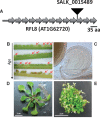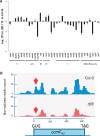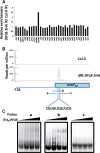A Case of Gene Fragmentation in Plant Mitochondria Fixed by the Selection of a Compensatory Restorer of Fertility-Like PPR Gene
- PMID: 33878189
- PMCID: PMC8321540
- DOI: 10.1093/molbev/msab115
A Case of Gene Fragmentation in Plant Mitochondria Fixed by the Selection of a Compensatory Restorer of Fertility-Like PPR Gene
Abstract
The high mutational load of mitochondrial genomes combined with their uniparental inheritance and high polyploidy favors the maintenance of deleterious mutations within populations. How cells compose and adapt to the accumulation of disadvantageous mitochondrial alleles remains unclear. Most harmful changes are likely corrected by purifying selection, however, the intimate collaboration between mitochondria- and nuclear-encoded gene products offers theoretical potential for compensatory adaptive changes. In plants, cytoplasmic male sterilities are known examples of nucleo-mitochondrial coadaptation situations in which nuclear-encoded restorer of fertility (Rf) genes evolve to counteract the effect of mitochondria-encoded cytoplasmic male sterility (CMS) genes and restore fertility. Most cloned Rfs belong to a small monophyletic group, comprising 26 pentatricopeptide repeat genes in Arabidopsis, called Rf-like (RFL). In this analysis, we explored the functional diversity of RFL genes in Arabidopsis and found that the RFL8 gene is not related to CMS suppression but essential for plant embryo development. In vitro-rescued rfl8 plantlets are deficient in the production of the mitochondrial heme-lyase complex. A complete ensemble of molecular and genetic analyses allowed us to demonstrate that the RFL8 gene has been selected to permit the translation of the mitochondrial ccmFN2 gene encoding a heme-lyase complex subunit which derives from the split of the ccmFN gene, specifically in Brassicaceae plants. This study represents thus a clear case of nuclear compensation to a lineage-specific mitochondrial genomic rearrangement in plants and demonstrates that RFL genes can be selected in response to other mitochondrial deviancies than CMS suppression.
Keywords: Rf-like PPR proteins; c-type cytochrome maturation; mitochondria; mitochondrial translation; plant respiratory mutant.
© The Author(s) 2021. Published by Oxford University Press on behalf of the Society for Molecular Biology and Evolution.
Figures





Similar articles
-
A restorer-of-fertility like pentatricopeptide repeat gene directs ribonucleolytic processing within the coding sequence of rps3-rpl16 and orf240a mitochondrial transcripts in Arabidopsis thaliana.Plant J. 2014 Apr;78(1):134-45. doi: 10.1111/tpj.12463. Epub 2014 Mar 12. Plant J. 2014. PMID: 24506331
-
The Restorer-of-fertility-like 2 pentatricopeptide repeat protein and RNase P are required for the processing of mitochondrial orf291 RNA in Arabidopsis.Plant J. 2016 Jun;86(6):504-13. doi: 10.1111/tpj.13185. Plant J. 2016. PMID: 27122350
-
Comparative genomic analysis of the compound Brassica napus Rf locus.BMC Genomics. 2016 Oct 26;17(1):834. doi: 10.1186/s12864-016-3117-0. BMC Genomics. 2016. PMID: 27782804 Free PMC article.
-
The Rf and Rf-like PPR in higher plants, a fast-evolving subclass of PPR genes.RNA Biol. 2013;10(9):1469-76. doi: 10.4161/rna.25568. Epub 2013 Jul 9. RNA Biol. 2013. PMID: 23872480 Free PMC article. Review.
-
What Does the Molecular Genetics of Different Types of Restorer-of-Fertility Genes Imply?Plants (Basel). 2020 Mar 13;9(3):361. doi: 10.3390/plants9030361. Plants (Basel). 2020. PMID: 32182978 Free PMC article. Review.
Cited by
-
MISF2 Encodes an Essential Mitochondrial Splicing Cofactor Required for nad2 mRNA Processing and Embryo Development in Arabidopsis thaliana.Int J Mol Sci. 2022 Feb 28;23(5):2670. doi: 10.3390/ijms23052670. Int J Mol Sci. 2022. PMID: 35269810 Free PMC article.
-
Types and Functions of Mitoribosome-Specific Ribosomal Proteins across Eukaryotes.Int J Mol Sci. 2022 Mar 23;23(7):3474. doi: 10.3390/ijms23073474. Int J Mol Sci. 2022. PMID: 35408834 Free PMC article. Review.
-
Molecular genetics of cytoplasmic male sterility and restorer-of-fertility for the fine tuning of pollen production in crops.Theor Appl Genet. 2023 Jun 18;136(7):156. doi: 10.1007/s00122-023-04398-8. Theor Appl Genet. 2023. PMID: 37330934 Review.
-
Pentatricopeptide repeat protein MITOCHONDRIAL STABILITY FACTOR 3 ensures mitochondrial RNA stability and embryogenesis.Plant Physiol. 2022 Aug 29;190(1):669-681. doi: 10.1093/plphys/kiac309. Plant Physiol. 2022. PMID: 35751603 Free PMC article.
References
-
- Alonso JM, Stepanova AN, Leisse TJ, Kim CJ, Chen H, Shinn P, Stevenson DK, Zimmerman J, Barajas P, Cheuk R, et al.2003. Genome-wide insertional mutagenesis of Arabidopsis thaliana. Science 301(5633):653–657. - PubMed
-
- Arnal N, Quadrado M, Simon M, Mireau H.. 2014. A restorer-of-fertility like pentatricopeptide repeat gene directs ribonucleolytic processing within the coding sequence of rps3-rpl16 and orf240a mitochondrial transcripts in Arabidopsis thaliana. Plant J. 78(1):134–145. - PubMed
Publication types
MeSH terms
Substances
LinkOut - more resources
Full Text Sources
Other Literature Sources
Molecular Biology Databases

